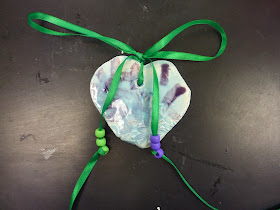In keeping with giving the students choices, I had 3 choices available for them.
The first choice started out by covering a piece of white watercolor paper with tissue paper. They used a paintbrush and water to adhere the tissue paper to the paper. Once the paper had dried, they took all of the tissue paper off and threw it away. The paper had bled onto the white paper, leaving a really unique effect for each paper. They used scrap wallpaper samples to cut out a vase (I gave them a template to trace) and glued this onto the now colored background. Each student glued 4 strips of green paper onto the vase, creating stems. Then I gave them a plate with a little bit of blue tempera and a little bit of white. I showed them how to use only their thumb to dip into the paint and stamp on their paper. They started by using the blue paint and then stamped the white paint on top.
The second choice also began by adding colored tissue paper to their white paper for the background. Once they had taken all of the dried paper off, they added their vase and stems. For this project, instead of painting their flowers on, they used white and blue bottle caps and buttons to create the bluebonnets. I gave each student some craft glue to dip their caps into and they placed them on the stems. I did not give them directions on the way that they should place their caps and buttons, but many of them naturally began making patterns, a good continuation from their math class.
The last project was done on burlap. While the other groups were working on tissue paper, this group was working on sewing. They used a marker and a ruler to draw a line from the top of their burlap to the bottom. This was their guide for sewing. They used a basic running stitch to create the stem of the bluebonnet. I spent the majority of the time with this group, while my student teacher worked with the 2 tissue paper groups.
When the stem was finished, they glued strips of green construction paper on to and then used blue and white paint to make their thumbprint bluebonnets.
























